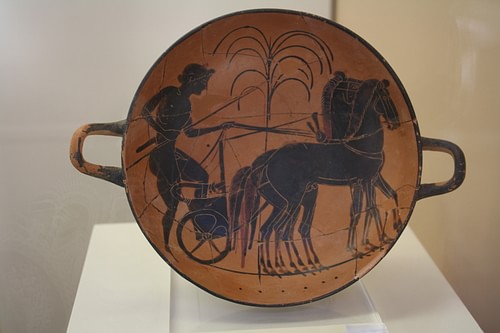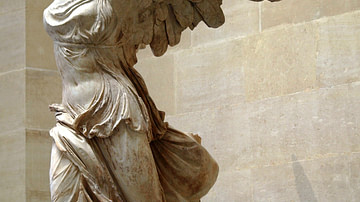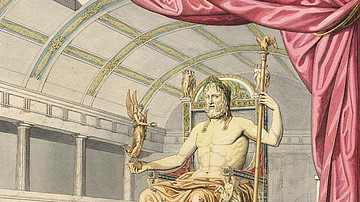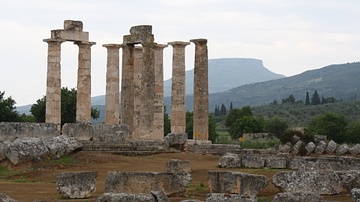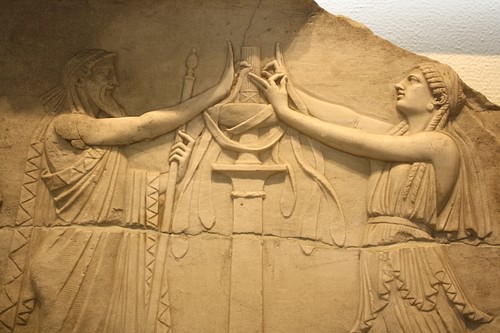
In the ancient Greek world, religion was personal, direct, and present in all areas of life. With formal rituals which included animal sacrifices and libations, myths to explain the origins of mankind and give the gods a human face, temples which dominated the urban landscape, city festivals and national sporting and artistic competitions, religion was never far from the mind of an ancient Greek. Whilst the individual may have made up their own mind on the degree of their religious belief and some may have been completely sceptical, certain fundamentals must have been sufficiently widespread in order for Greek government and society to function: the gods existed, they could influence human affairs, and they welcomed and responded to acts of piety and worship.
The Olympian Gods
Polytheistic Greek religion encompassed a myriad of gods, each representing a certain facet of the human condition, and even abstract ideas such as justice and wisdom could have their own personification. The most important gods, though, were the Olympian gods led by Zeus:
These 12 Olympian gods were believed to reside on Mt. Olympus and would have been recognised across Greece, albeit, with some local variations and perhaps particular attributes and associations.
In the Greek imagination, literature, and art, the gods were given human bodies and characters - both good and bad - and just as ordinary men and women, they married, had children (often through illicit affairs), fought, and in the stories of Greek mythology they directly intervened in human affairs. These traditions were first recounted only orally as there was no sacred text in Greek religion and later, attempts were made to put in writing this oral tradition, notably by Hesiod in his Theogony and more indirectly in the works of Homer.
Temples, Rituals & Priests
Gods became patrons of cities, for example, Aphrodite for Corinth and Helios for Rhodes, and were called upon for help in particular situations, for example, Ares during war and Hera for weddings. Some gods were imported from abroad, for example, Adonis, and incorporated into the Greek pantheon whilst rivers and springs could take on a very localised personified form such as the nymphs.
The temple (naos - meaning dwelling place in reference to the belief that the god dwelt in that place, or at least temporarily visited during rituals) was the place where, on special occasions, religion took on a more formal tone. Gods were worshipped at sacred sites and temples in all major Greek communities in ceremonies carried out by priests and their attendants.
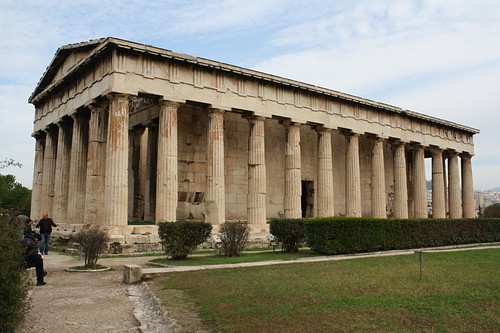
At first, sacred sites were merely a simple altar in a designated area, but over time massive temples came to be built in honour of a particular god and these usually housed a cult statue of the deity, most famously the huge statue of Athena in the Parthenon of Athens or Zeus at Olympia. In time, a whole complex of temples to lesser gods could spring up around the main temple, creating a large sacred complex, often built on an acropolis dominating a city or surrounding area. This sacred area (temenos) was separated from the rest of the community by a symbolic gate or propylon, and in fact, it was believed that this area belonged to the particular deity in question. Sacred sites also received financial donations and dedications of statues, fountains and even buildings from the faithful, often to celebrate a great military victory and give thanks to the gods, and larger sanctuaries also had permanent caretakers (neokoroi) who were responsible for the upkeep of the site.
The temple itself, though, was not used during religious practices as these were carried out at a designated altar outside the temple. Ancient authors often show a reluctance to go into explicit details of religious ceremonies and rites as if these were too sacred to be publicised in the written word. What we do know is that the most common religious practices were sacrifice and the pouring of libations, all to the accompaniment of prayers in honour of the god. The animals sacrificed were usually pigs, sheep, goats or cows and always the same sex as the god which was being honoured. The meat was then either burnt completely or cooked, with part offered to the god and the rest eaten by some or all of the worshippers or taken away to be eaten later. The actual killing of the animal was carried out by a butcher or cook (megeiras) whilst a young girl sprinkled seeds onto the animals head, perhaps symbolic of life and regeneration at the moment of the animal's death. Other such rituals included examining the entrails of sacrificed animals to ascertain signs which could help predict future events.
Priests then, orchestrated the religious ceremonies and delivered prayers. The position was generally open to all and once assuming the role, particularly when wearing the sacred headband, the body of the priest became inviolate. Priests served a specific god but they were not necessarily religious experts. For theological questions, a citizen could consult an exegetes, a state official, who was knowledgeable in religious affairs. Women could also be priests, which is perhaps surprising given their lack of any other public role in Greek society. Often, but not always, the priest was the same sex as the god they represented. Priestesses did have the added restriction that they were most often selected because they were virgins or beyond menopause. Worshippers, on the other hand, could be both sexes and those rituals with restrictions could exclude either men or women.
Mysteries & Oracles
In addition to the formal and public religious ceremonies there were also many rites which were open to and known only by the initiated who performed them, the most famous example being the Mysteries of Eleusis. In these closed groups, members believed that certain activities gave spiritual benefits, amongst them a better after-life.
Places could also acquire a divine connection; the great oracles such as that of Apollo at Delphi and Zeus at Dodona may well have begun as places considered particularly good to receive signs from the gods. Such places became hugely important centres with their priest oracles consulted by both individuals and city-states so that the rather vague and ambiguous proclamations might help guide their future conduct.
Festivals & Games
Athletic Games and competitions in music (especially playing the kithara and lyre) and theatre (both tragedy and comedy) were held during festivals such as the City Dionysia of Athens and the Panhellenic games at the most important sacred sites of Olympia, Delphi, Nemea, and Isthmia to honour a particular god. These events were attended by visitors from all over Greece and the experience was perhaps more akin to a pilgrimage rather than that of a mere sports fan. Illustrating their sacred status, warfare was prohibited during these events and pilgrims were guaranteed free-passage across Greece. However, there were also much smaller festivals, sometimes only attended by a very select number of individuals, for example, the Arrhephoria in Athens, where only priestesses and a maximum of four young girls participated.
Personal Religion
Although the historical record reveals much about formal religious occasions and ceremony, we should remember that Greek religion was in fact practised anywhere, at any time, by private individuals in a very personal way. Not only temples but also the hearth in private homes was regarded as sacred, for example. Individuals could also visit a temple anytime they wanted to and it was customary to say a prayer even when just passing them in the street. People left offerings such as incense, flowers, and food, no doubt with a hopeful prayer or in gratitude for a past deed. Individuals could also organise their own private sacrifice if they had the means to do so, and these have been commemorated in thousands of stone relief markers found at sacred sites. In addition, temples were often visited in order to seek healing, especially at those sites associated with Asclepius the god of medicine, notably at Epidaurus.
People also looked for signs from the gods in everyday life and to interpret these signs as indicators of future events. Such signs could be birds in the sky or a spoken word between friends said at a particular moment or even a simple sneeze which might be interpreted as an auspicious or inauspicious omen.
Such beliefs and, indeed, certain aspects of religion such as the immorality of the gods as portrayed in the arts, were severely criticised by intellectuals, artists, and philosophers from the 5th century BCE, but these may or may not reflect the commonly held views of the wider populace, and it is difficult to believe from the wealth of archaeological and written records that religion was anything but a fundamental part of life for the ordinary inhabitants of the ancient Greek world.

